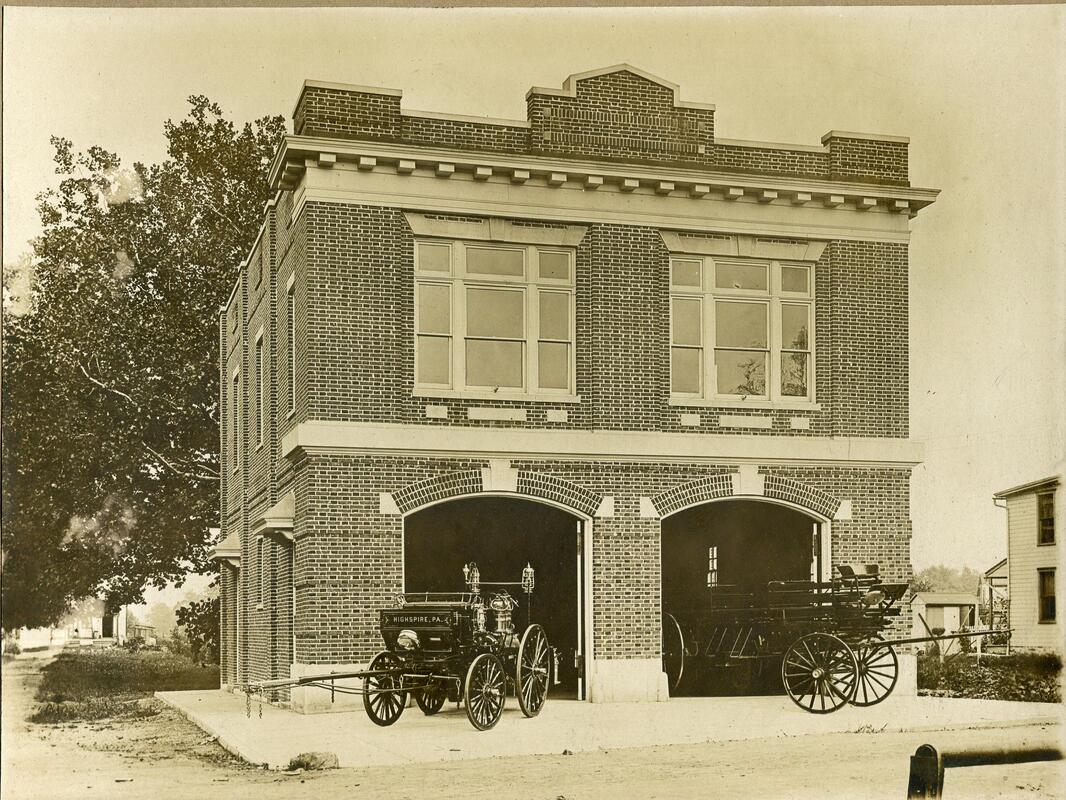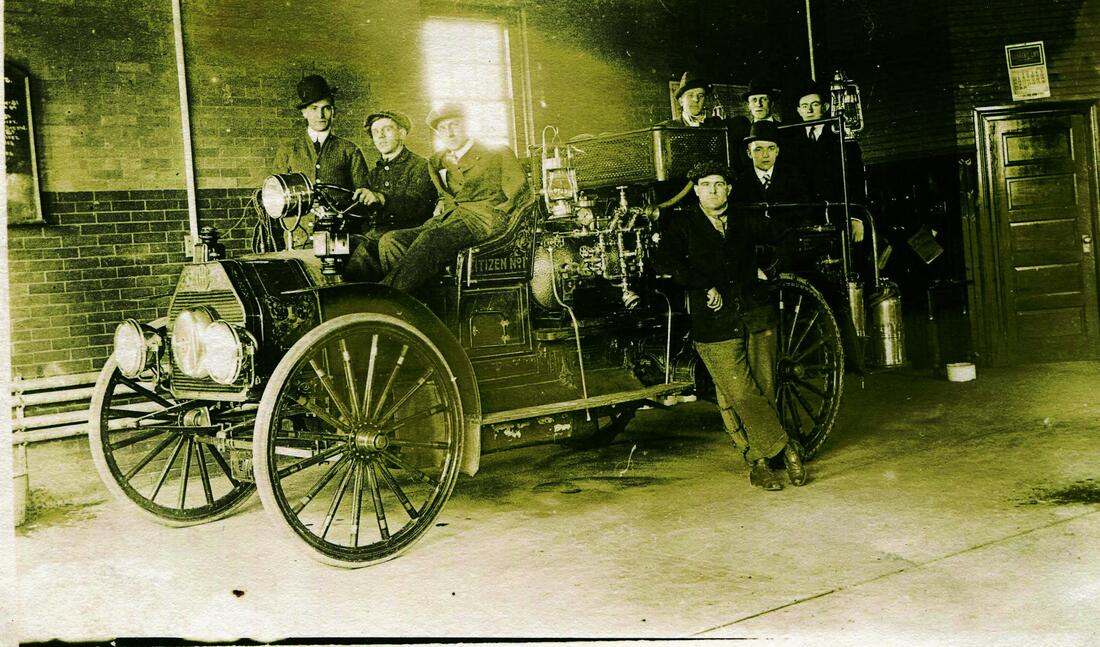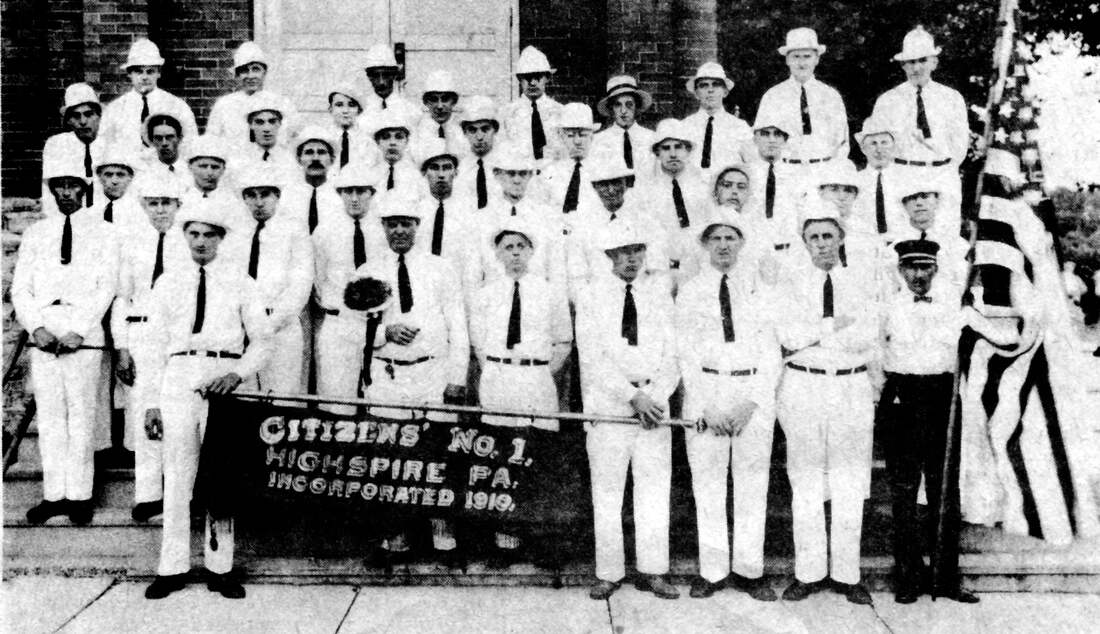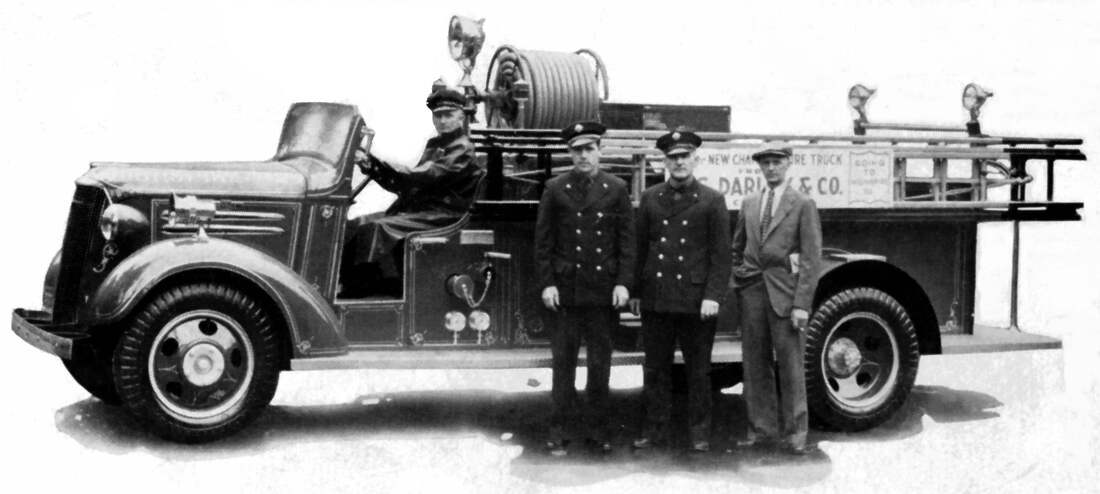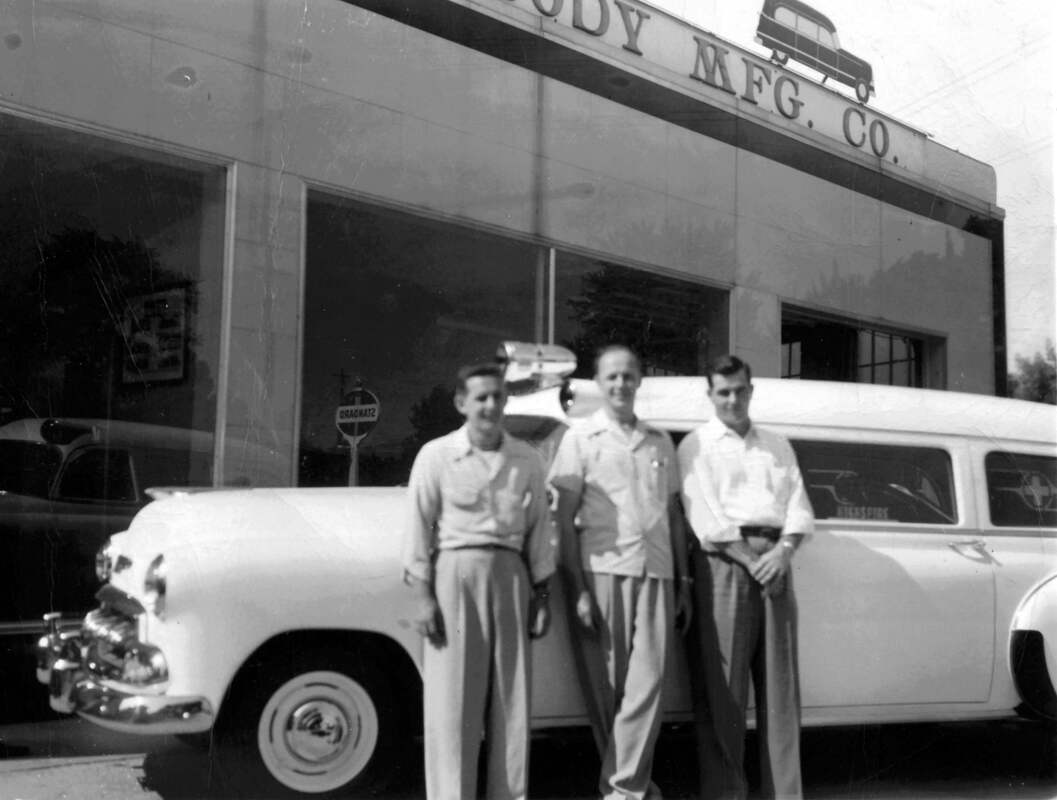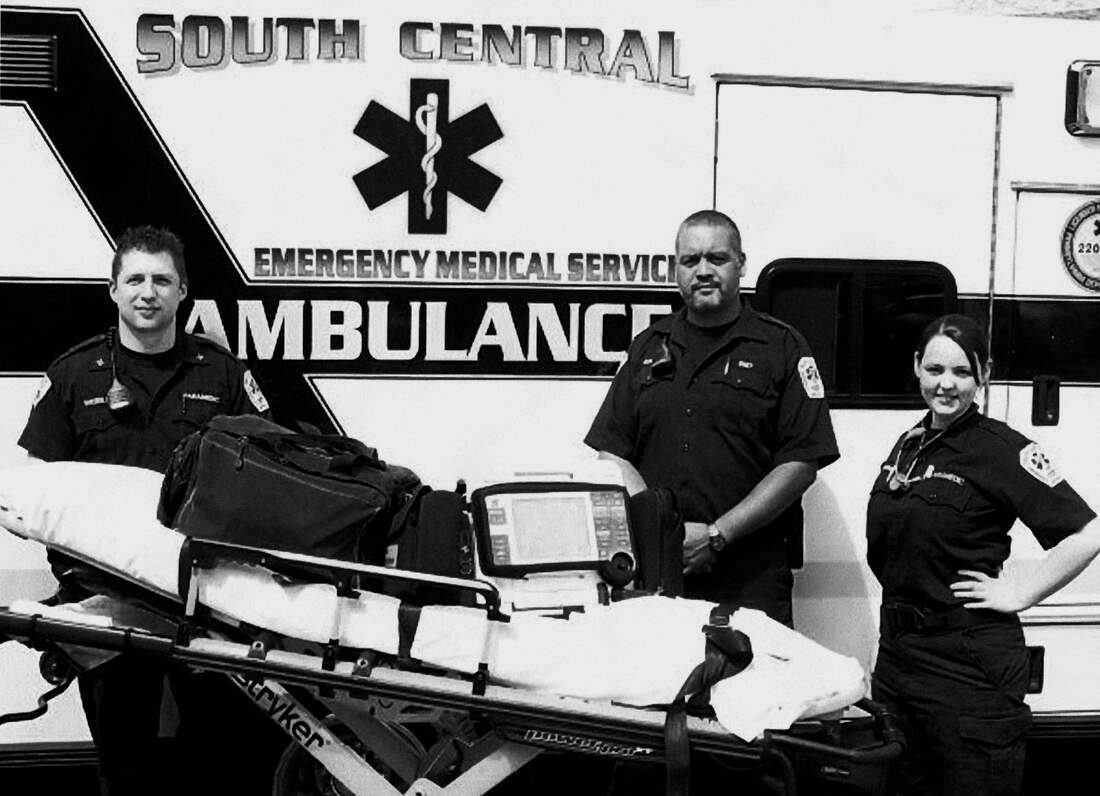Emergence Services
Citizens Fire Company No. 1
Property loss due to fire was far more common in the era of open-flame heating systems in the 19th and early 20th centuries, and before the advent of water systems and modern fire suppression equipment. One of the first objectives of the new borough was the improvement in firefighting capability. A volunteer fire company, Citizens Fire Company No. 1, was incorporated in 1910.
The first horse-drawn fire truck was ordered from La France Co. in 1910, and a fire house and council chamber was built in 1911 on the southeast corner of Paxton and Broad streets. The first motorized fire truck in Dauphin County was purchased by the Borough of Highspire in 1914, and in 1923 an American La France pumper was purchased.
The first horse-drawn fire truck was ordered from La France Co. in 1910, and a fire house and council chamber was built in 1911 on the southeast corner of Paxton and Broad streets. The first motorized fire truck in Dauphin County was purchased by the Borough of Highspire in 1914, and in 1923 an American La France pumper was purchased.
New fire house built in 1911 on the southeast corner of Paxton and Broad Streets
with horse drawn fire fighting apparatus.
with horse drawn fire fighting apparatus.
The borough’s first motorized fire truck was purchased in 1914. This picture is taken inside the original 1911 fire station on the southeast corner of Paxton and Broad streets.
Members of Citizens Fire Company No. 1 gathered in 1928.
Before fire hydrants were installed in 1930, concrete weirs were built along the small streams with wooden dams that could be lowered into the weir to block the stream and create a reservoir for pumping water to fight fires. In the mid-1930s Citizens Fire Company No. 1 raised funds for the purchase of a 1937 Chevrolet pumper truck. With the purchase of the second pumper, insurance rates in the borough dropped significantly.
1937 Chevrolet pumper fire truck.
1958 International pumper fire truck.
The late 1950s saw the implementation of central emergency dispatch for Dauphin County. Prior to that, fire calls were made directly to a fire station or by going there in person and pushing a siren button. The initial county emergency dispatch system relied on a regular seven-digit Harrisburg telephone number. After two decades with that system, 9-1-1 was implemented countywide in 1978, and in the early 1990s contracts were awarded for Enhanced 9-1-1 services, including the interface with wireless telephone networks.
The size of modern fire trucks finally made the station at Broad and Paxton streets obsolete. A new truck purchased in the 1960s had only a few inches of clearance to get through the bay doors. The fire company asked the borough to modify the bay doors to one large door. When engineers inspected the building they warned that it was structurally unsound and recommended the second floor be closed immediately. Since the borough said it could not afford to build a fire station, the fire company raised the funds to purchase property on Second Street and build a station. Mayor Earl Hoffman Sr. was instrumental in bringing the project to fruition. The new station, owned by the fire company, was completed in 1971.
The size of modern fire trucks finally made the station at Broad and Paxton streets obsolete. A new truck purchased in the 1960s had only a few inches of clearance to get through the bay doors. The fire company asked the borough to modify the bay doors to one large door. When engineers inspected the building they warned that it was structurally unsound and recommended the second floor be closed immediately. Since the borough said it could not afford to build a fire station, the fire company raised the funds to purchase property on Second Street and build a station. Mayor Earl Hoffman Sr. was instrumental in bringing the project to fruition. The new station, owned by the fire company, was completed in 1971.
The new fire station on Second Street between Paxton and Lumber streets was completed in 1971. It has two wide drive-through bays and a large meeting room.
(Photo by Robert Keifer, courtesy of his nephew Don Ruth)
(Photo by Robert Keifer, courtesy of his nephew Don Ruth)
This is Citizens Fire Company No. 1’s newest engine, a 1992 Pemfab. There have been modifications to the body since this picture was taken. (Photo courtesy of Highspire Citizens fire Company No. 1)
Unlike 100 years ago when the fire company was formed, few of today’s calls are for structural fires. The majority of emergency calls today are for hazardous materials spills, motor vehicle accidents and fires, and medical emergencies. While the fire company does not transport patients to hospitals, its emergency medical technicians will try to stabilize the patient until the South Central Emergency Medical Services ambulance arrives.
A lot of training is required for today’s volunteer firefighters. It takes about 215 hours of training to qualify to go into a burning building. Officers require 400 or more hours of training.
The majority of the fire company’s operating budget comes from fundraising efforts such as the Sunday dinners that are held every two weeks, fund drives, and their annual carnival. The Borough of Highspire allocates $2,000 per month to the fire company to assist with operating expenses. In addition, the borough also pays for the fire company’s Worker’s Compensation, insurances, hydrant service and makes a contribution towards the savings for a new fire truck. In 2013 the total borough support for the fire company was $78,350. A small part of the budget derives from charitable donations, state grants and fire insurance taxes allocated to the Volunteer Firefighters’ Relief Associations.
A lot of training is required for today’s volunteer firefighters. It takes about 215 hours of training to qualify to go into a burning building. Officers require 400 or more hours of training.
The majority of the fire company’s operating budget comes from fundraising efforts such as the Sunday dinners that are held every two weeks, fund drives, and their annual carnival. The Borough of Highspire allocates $2,000 per month to the fire company to assist with operating expenses. In addition, the borough also pays for the fire company’s Worker’s Compensation, insurances, hydrant service and makes a contribution towards the savings for a new fire truck. In 2013 the total borough support for the fire company was $78,350. A small part of the budget derives from charitable donations, state grants and fire insurance taxes allocated to the Volunteer Firefighters’ Relief Associations.
Emergency Medical Services
The earliest record we have of an ambulance service in Highspire is an article in the Harrisburg Telegraph newspaper of September 16, 1872. An article on a Liberal Republican Party parade in Harrisburg for presidential candidate Horace Greeley mentioned two Highspire ambulance wagons participating. We have no record of what community organizations might have operated or sponsored those ambulance wagons.
Modern Highspire ambulance service traces its beginnings to the post-World War II era. In 1947 free ambulance service was begun under auspices of the Highspire American Legion Post 945. Donald Beard and Wilbert Dengler were co-chairmen of a campaign to raise $2,500 to support the ambulance service. Funds were raised in Highspire and surrounding areas. The ambulance service was staffed by volunteers; Kenneth Knight and Gale Schiefer handled most of the emergency runs. The ambulance service continued to be sponsored by the American Legion until the Highspire Legion Post dissolved in the late 1960s.
Modern Highspire ambulance service traces its beginnings to the post-World War II era. In 1947 free ambulance service was begun under auspices of the Highspire American Legion Post 945. Donald Beard and Wilbert Dengler were co-chairmen of a campaign to raise $2,500 to support the ambulance service. Funds were raised in Highspire and surrounding areas. The ambulance service was staffed by volunteers; Kenneth Knight and Gale Schiefer handled most of the emergency runs. The ambulance service continued to be sponsored by the American Legion until the Highspire Legion Post dissolved in the late 1960s.
Pictured left to right beside a 1952 Chevrolet ambulance are Gale Schiefer,
Harry Gross and Wilbert Dengler.
Harry Gross and Wilbert Dengler.
In the early 1970s the Highspire Community Ambulance Association was incorporated to provide ambulance service to Highspire and surrounding areas. Kenneth Knight was chairman, Jerry Walck was vice chairman, and Dorothy Knight was secretary-treasurer and ambulance dispatcher. Funds were raised through association memberships and community fund drives. Ken Knight and Jerry Walck were the first certified emergency medical technicians in Dauphin County.
With the ever-increasing need for training and certification, it became more difficult to staff the service with volunteers. Finally, in 1998 the Highspire Community Ambulance Association was merged with the ambulance service of Lower Swatara Township, which had full-time, paid emergency medical staff. All the assets of the association were transferred to Lower Swatara Township at that time. Since 2003, advanced and basic life support services for Highspire residents has been provided by South Central Emergency Medical Services, which serves seven other municipalities in Dauphin County.
With the ever-increasing need for training and certification, it became more difficult to staff the service with volunteers. Finally, in 1998 the Highspire Community Ambulance Association was merged with the ambulance service of Lower Swatara Township, which had full-time, paid emergency medical staff. All the assets of the association were transferred to Lower Swatara Township at that time. Since 2003, advanced and basic life support services for Highspire residents has been provided by South Central Emergency Medical Services, which serves seven other municipalities in Dauphin County.
The South Central Emergency Medical Service currently has provided 24-hour, 365-days-per-year advanced and basic life support services to Highspire since 2003. (Photo courtesy of South Central Emergency Medical Service)
